Adventures With Saguaros….
When many people think of the Desert Southwest, the iconic Saguaro cactus comes to mind. I remember seeing my first saguaro, crossing over the California Arizona border. When I first saw them, it was hard to believe that they were real. They were so strange looking to my eyes.
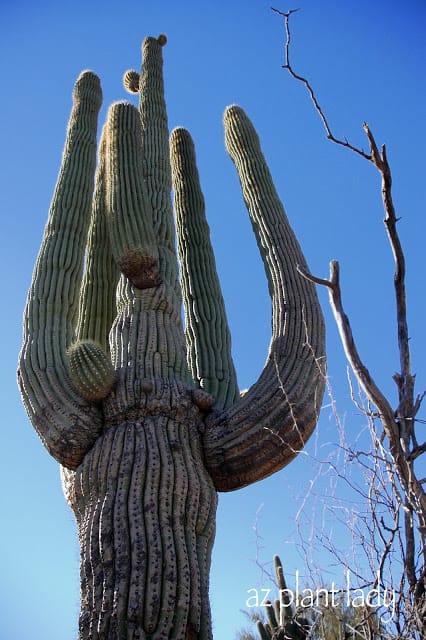
Throughout my career as a horticulturist, I have had many interactions with these beautiful cacti. Most of them were quite wonderful really, but there were some that were not so much fun…..
One incident was quite painful. I remember a time when we were creating pathways for a potential botanical walk when I spotted a small saguaro (8 inches tall) that was directly in the path, so I had it dug up in order to place it elsewhere. Well, I pricked my thumb on one of the spines, but I didn’t think anything of it because I frequently stuck myself with other types of cacti and agave.
Well my thumb began to swell….and swell. It got to the point 3 days later that I could not use my hand, so I had to go to the doctor for some antibiotics, which took care of the problem. Spines oftentimes have bacteria on the tips which can cause problems if you get stuck.
Another incident was quite painful as well, but not physically. This involved one of my favorite saguaros that was located in a large feature area alongside the golf course where I worked. I had transformed this landscape area into a hummingbird garden. The saguaro was huge and had many arms growing from it.
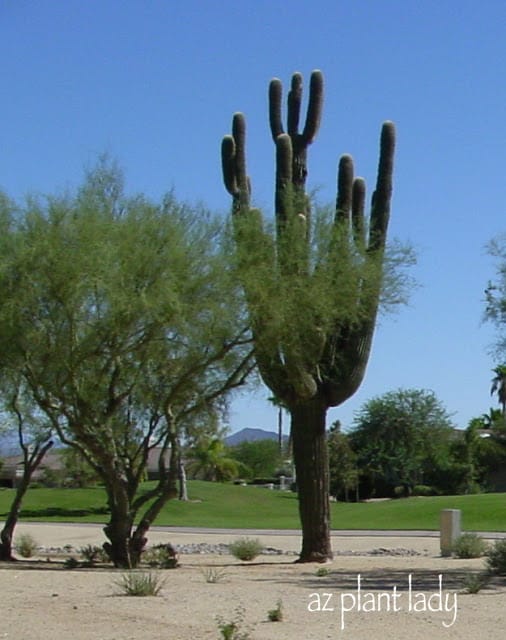
This photo was taken when we had just finished adding the plants in our hummingbird garden.
A few years later, as I was driving to work on a gorgeous summer morning, little did I know that my beautiful saguaro had fallen victim to the torrential rain and high winds we had experienced the night before.
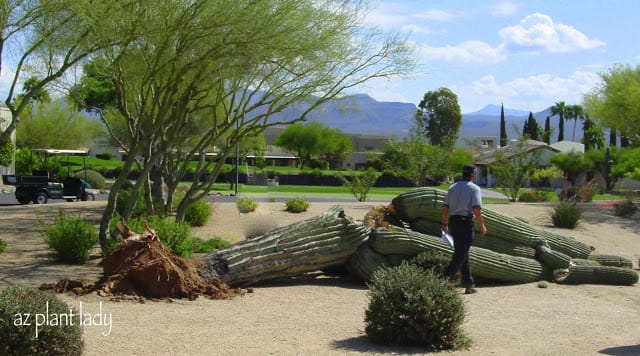
As soon as I had arrived at work, my crew told me what had happened and I drove my little golf cart out there as fast as possible.
It was such a sad sight. I literally felt sick to my stomach. To get a sense of how large it was, my co-worker who is pictured above is about 6′ 4″ tall.
As I got up close to examine it, I saw something else that was also quite sad….
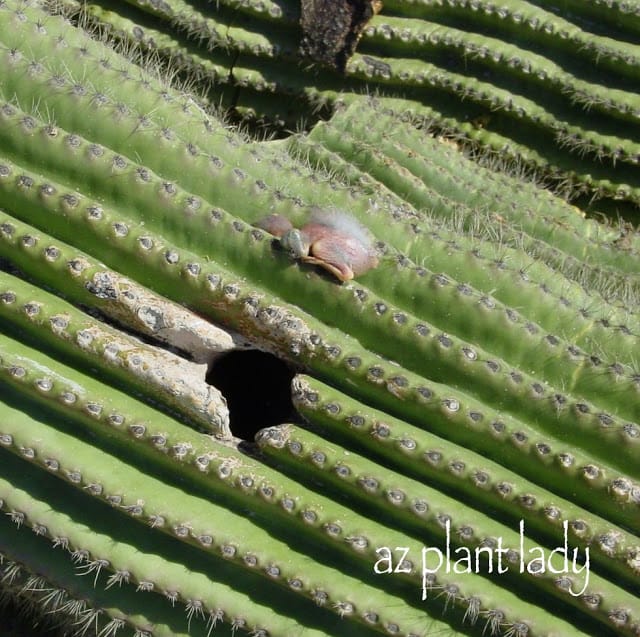
A tiny baby Cactus Wren had also fallen victim. The force of the falling saguaro dislodged him from his nesting hole. His mother was close by and had also died.
The last incident that I would like to share with you also happened around the time of the fallen saguaro.
I was driving around the golf courses, checking on landscape areas and the many trees that we had growing on the courses. This was part of my daily routine.
There were beautiful homes and landscapes that backed up to the golf courses. As I was passing one of the homes, I noticed something up in the top reaches of their stately saguaro that was not a welcome sight.
Did you know that saguaros can get sick?
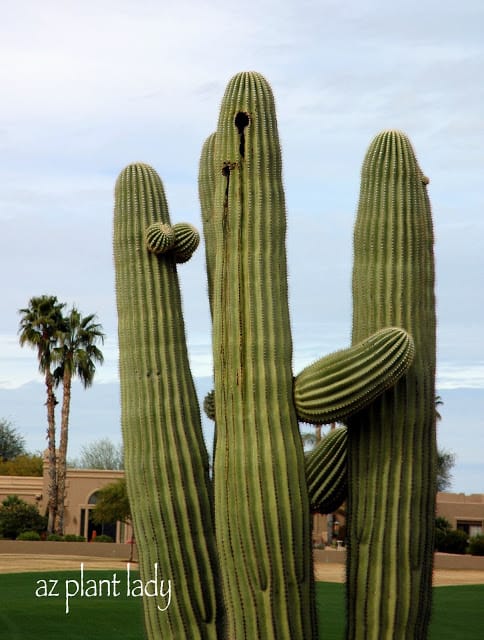
Okay, it may not be obvious, but look closely towards the top. Do you see two brown/black spots with liquid seeping out?
Here was a classic example of bacterial necrosis (Erwinia carnegieana).
The ‘black goo’ that is excreted smells absolutely awful. You may be wondering how it spreads. Well, insects and small animals are the primary way that it is spread. They visit an infected cactus and then fly to your cacti, spreading the bacteria.
So, can you leave it alone and hope it will go away? Well, there is a chance that the saguaro itself can seal off the infection by forming a special kind of tissue known as ‘callus’.
But this is not always successful and if the bacterial necrosis spreads, it will lead to the death of your saguaro, causing it to fall, which can also cause damage to those things that are in its path.
So what can you do?
Well, if the infection is where you can reach it, you can cut out the infected area. Using a sharp knife, begin cutting out all black, gooey areas, taking care to sterilize your knife after each cut using rubbing alcohol.
You need to remove all diseased cactus flesh and cut into at least a 1/2″ of healthy saguaro tissue. To make sure that water cannot accumulate in the area, use a spoon to gently slope the bottom of the hole. Make sure that the walls of the now enlarged hole are smooth with no puncture marks.
The last step involves spraying the entire, excavated area with a 10% bleach mixture (9 parts water to 1 part chlorine bleach). This should kill any remaining bacterial.
Another option is that you can call a cactus professional and have them treat the infection.
For more information you can click here. About halfway down the page, you will find excellent information on bacterial necrosis.
I am happy to say that there is a happy ending to this last saguaro incident…..the homeowners had it treated and it is still alive and thriving 8 years later 🙂

 Noelle Johnson, aka, 'AZ Plant Lady' is a author, horticulturist, and landscape consultant who helps people learn how to create, grow, and maintain beautiful desert gardens that thrive in a hot, dry climate. She does this through her consulting services, her online class Desert Gardening 101, and her monthly membership club, Through the Garden Gate. As she likes to tell desert-dwellers, "Gardening in the desert isn't hard, but it is different."
Noelle Johnson, aka, 'AZ Plant Lady' is a author, horticulturist, and landscape consultant who helps people learn how to create, grow, and maintain beautiful desert gardens that thrive in a hot, dry climate. She does this through her consulting services, her online class Desert Gardening 101, and her monthly membership club, Through the Garden Gate. As she likes to tell desert-dwellers, "Gardening in the desert isn't hard, but it is different."









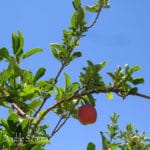

Oh Noelle! How tragic to see the fallen saguaros! The baby bird we can see and perhaps others still hidden within the nest . . . victims along side their nest provider. Very sad. I know how hard it must be to see a large . . . so like a tree . . . saguaro you know and love die this way. I hope the last one you feature does survive.
Those gigantic cacti must be like trees in the sense of a landscaping investment, yes? Another fun fact about them, which a lot of people do not know, is that they don't grow in Texas, despite all those old Westerns supposedly set in Texas that show cowboys riding past them.
Thank you for sharing so many unknown plants and wonderful information about them.
That is one of the hardest things to see in different yards around here….some saguaro are perfectly healthy and others that are moved because of progress…and then slowly watch them die because they were moved. Right now, I have one in a PLANTER!!! And I don't know what to do as it's been there for years. I have to have someone official come from the city to safely remove it and take it someone on the property where it will grow. These things are sacred plants and should be better protected!
Hi Noelle,
What a thrill it is too see these magnificent plants and how sad to see that one that fell along with the cactus wren. We gardeners take to heart the loss of our friends. Thank you for reminding me just how fragile life is no matter how strong or how tall you are!
I would also like to add you blog to my blog roll. My husband is a huge fan of cacti and succulent plants. I know he will enjoy your blog, too.
Carla
Years ago, when our two children were still in school, we visited my relatives in Tucson. I purchased a book entitled "Cactus Hotel." If you're not familiar with it, you should look it up. It's a very special book that chronicles the life of a saguaro and tells the age of the cactus as it grows. You would like it. 🙂
This was a very nice post.
Dear Noelle, A truly fascinating post! My son has a beautiful, giant saguaro in his back yard (he recently moved to Phoenix). I've seen pictures, but not in real life as yet. I had no idea there were cactus professionals … although it is obvious really. Loved this post. P x
what a shame all the way around, such magnificent cacti. I had no idea these were this large or were damaged like this.
Interesting stores about this cacti! I was very amazed when I saw Saguaro cactus during my December visit to Phoenix.
What an interesting post! I would have cried over the fallen cactus and the little birds. It is always hard to see the destructive side of nature.
So sad to see that giant saguaro felled by the storm. I know it must have been very old, so it would be like having an old oak tree struck by lightning or a storm. On my first visit to the DBG, we had an excellent tour guide who shared a lot of fun facts about the different cacti. I remember him saying that often a large snake would sometimes use a hole for its nest. Since then, I've never gotten too close to a saguaro to investigate it:)
What an interesting post Noelle, I really enjoyed it. Although the plight of the cactus wrens was very sad, as was the demise of that lovely Saguaro in the storm.
Hi, Noelle;
What a great post. It just broke my heart to see that magnificent saguaro lying on it's side. And then to see that the accident took the lives of the little birds…